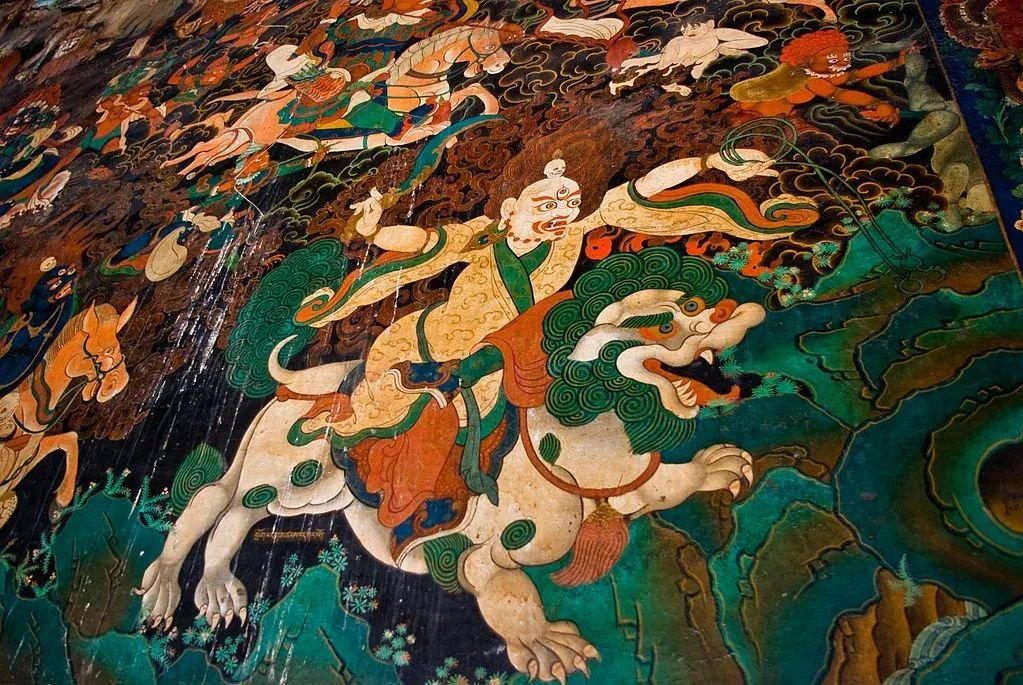The Nechung Temple is located in the western suburbs of Lhasa, approximately 1000 meters from the Drepung Monastery. Its full name is “Nechung Drayang Ling” and it serves as the residence of the worldly protector deity Pehar, the most popular deity in Tibetan Buddhism.
Constructed in the 17th century, the temple has a square layout consisting of corridors, main halls, and auxiliary halls. In the courtyard’s centre, there is a blank stone stele with two incense burners on either side. To the west of the corridor, there are three stone shrines. Pehar is located in the middle, serving as the protector deity on the west, while Ziwu Ma is the protector deity on the east. In front of the main hall, two stone lions are present, and the walls on both sides are adorned with images of Pehar Gyalpo. The main hall is surrounded by several auxiliary halls, with the most renowned being the Pehar Hall in the northwest corner.
The hall also houses an ancient tree, where Pehar transformed into a white pigeon. The tree is now adorned with a ceremonial white scarf. Additionally, there is a shrine for Pehar to the right of the sacred tree and a shrine for Guru Rinpoche to the left. The main hall contains the Nechung Dharma Protector Hall, the most sacred space within the temple. It features a silver-inlaid carved altar, upon which the ceremonial robe and helmet are placed. The entire temple exudes a sense of exquisiteness, compactness, solemnity, and majesty.
Beautiful Murals inside Nechung Monastery
Apart from the Guge murals and the Palkor Choede Monastery murals, the Nechung Temple murals are distinctively captivating. Painted during the mid-17th century, they cover the walls of the main hall and corridors, serving as a concentrated embodiment of the artistic style of that era. The murals primarily depict Pehar and his incarnations, along with his companion deities. They also highlight scenes of beings undergoing karmic retribution in hell for the evil deeds committed in their past lives. The paintings possess independent content, with a significant focus on characters.

The murals depict a three-headed, six-armed Pehar wearing a Nechung hat, exposing his chest and belly, with human and tiger skin around his waist. He dons a necklace made of human heads around his neck. In his main two hands, he holds a bow as if shooting arrows, while his four backhands grasp a knife, sword, hook, and staff. He sits on a fierce lion, adopting a posture that intimidates the three realms. Minimal background decoration is present, and the predominant colours employed are cool tones, with gold, black, and purple accents, creating a visually rich and magnificent composition. The painting technique combines single-line flat coating and smudging, utilizing slightly darker colours than the subject to outline the forms.
Tibetan art during the medieval period was heavily influenced by the art of the Chinese, Indian, and Central Asian Mongolian nomads. The murals exemplify divine art, depicting warriors on horseback wearing helmets, armour, and wielding spears, showcasing the distinctive features of Central Asian Mongolian nomadic art. The statues of deities and Buddhas in the paintings, particularly the tantric Buddhas and the goddess Tara, reflect the style of Indian art. The influence of Chinese art and neighbouring countries such as Nepal and Kashmir is primarily evident in the portrayal of secular figures and background decorations, which are both exquisite and elegant. These murals represent Tibet’s valuable artistic heritage and possess significant artistic worth.
Pehar Gyalpo
Pehar, a renowned protector deity in Tibetan Buddhism, was initially the guardian deity of the local Turkic region. Guru Rinpoche invited Pehar to serve as the protector of Samye Monastery in Tibet. Subsequently, the 5th Dalai Lama invited Pehar to the Nechung Temple in Lhasa, where he became the primary deity worshipped by the Gelug sect, known as the Nechung Protector Deity. Pehar is depicted with a wrathful appearance, possessing one face and two hands. In his right hand, he holds a short axe in front of his chest, while his left hand supports a skull bowl on top of his head. The statue is exquisitely crafted.
According to the Gelug school, Pehar is the main worldly protector, commonly called “Nechung”. However, other Tibetan Buddhist sects view Pehar as a subordinate deity, like the Nyingma school. Various theories exist about the origin of Pehar’s name, some suggesting it comes from the Sanskrit word “Vihaara”, and others from the Turkic word “Bag” or the Persian word “Paihar”. The most accepted theory states that his father is the Lord of Day, and his mother is the Dragon Princess of Wealth, also known as the “Nine-Headed Dragon Princess”. After birth, Pehar resided in the heavenly realm and ruled the Thirty-Three Gods as the god Indra. In the Middle Ages, he descended to the human realm and settled in the Hor region, known as the “Crystal White Ghost”. As he oversaw local monasteries in Bada Hor, he was called the “Lord of Pehar”.
In the 8th century, Pehar became a protector deity at Samye Monastery. Later, he was moved to Nechung Monastery in Lhasa and became the main protector deity. He is responsible for accomplishment and has different incarnations called the Five Body Kings.

